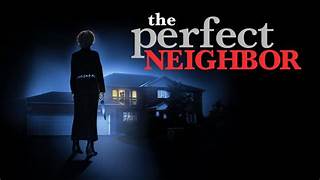True-crime documentaries have long gripped American audiences, but few are as disturbing — and potent — as The Perfect Neighbor. Released on Netflix in October 2025, this film dives deep into a suburban neighborhood feud that escalated into murder. With its raw presentation, the documentary not only tells a harrowing personal story but also shines a light on broader issues like race, gun laws, and community surveillance.
In this post, we’ll explore who is Susan Lorincz, who was Ajike “AJ” Owens, what led to the fatal confrontation, how the documentary was made, and why it’s already sparking national conversations.
What Is The Perfect Neighbor?
The Perfect Neighbor is a 2025 American documentary directed by Geeta Gandbhir.The film’s official description states that it recounts the tension between two neighbors in Ocala, Florida, culminating in a fatal shooting that shockingly occurred through a locked door.
Unlike many documentaries that rely heavily on narrators or reconstructed scenes, The Perfect Neighbor is built almost entirely from police bodycam footage, 911 calls, surveillance video, and court documents. This immersive approach forces viewers to witness the events as they unfolded — unfiltered, uncomfortable, and unrelenting.
The film premiered at the 2025 Sundance Film Festival on January 24, and Netflix picked it up shortly thereafter. It’s set to stream globally beginning October 17, 2025 (after a limited theatrical release).
The People Behind the Story: AJ Owens & Susan Lorincz
Ajike “AJ” Owens
Ajike “AJ” Shantrell Owens was a 35-year-old mother of four living in Ocala, Florida. Known to her friends and family as a devoted mother, she worked hard to support her children and took active roles in their lives.
Her life, unfortunately, was cut short on June 2, 2023, when she was shot through a locked door by her neighbor, Susan Lorincz.
Susan Lorincz
Susan Lorincz resided next door to the Owens family and, over time, became embroiled in a bitter dispute with AJ and her children. Reports from the documentary and public records indicate a history of complaints made by Lorincz about the Owens children — noise, trespassing, neighborhood disturbance — with claims that she even used racial slurs against them.
Lorincz allegedly threw a roller skate at one of AJ’s children and swung an umbrella at another during earlier confrontations — actions she denied in court but which were cited by witnesses and police reports.
On the night of the fatal shooting, Owens approached Lorincz’s front door to confront her over these tensions. Lorincz fired through the locked door and struck Owens, who died shortly afterward.
During her trial, Lorincz claimed self-defense, citing Florida’s “stand your ground” law. Her defense argued she felt threatened, though prosecutors and the jury rejected that version, finding her actions unjustified.
In August 2024, Lorincz was convicted of manslaughter and later sentenced to 25 years in prison in November 2024.
Why The Perfect Neighbor Matters
A Heightened Focus on Stand-Your-Ground Laws
One of the most pressing themes of The Perfect Neighbor is its examination of Florida’s stand-your-ground legislation. These laws permit individuals to use deadly force when they perceive a threat, without a duty to retreat first.
Critics argue these laws often empower aggressive behavior and disproportionately affect Black communities. The film doesn’t shy away from showing how a legal doctrine intended to protect can, in some cases, facilitate unnecessary violence.
The Power of Raw Evidence
By relying almost entirely on unedited bodycam footage, 911 call audio, and surveillance video, the documentary aims to minimize editorial bias and let the events speak for themselves.
This method forces viewers to sit with discomfort, contradictions, and ambiguity — amplifying the emotional weight of what took place.
Racial and Social Context
The case resonates beyond a simple neighbor dispute. It speaks to systemic patterns of racial tension, surveillance of Black communities, and the way perceived “disorder” by marginalized groups is often criminalized.
Gandbhir, the director, has said she wanted The Perfect Neighbor to explore the transforming of grief into purpose while igniting conversation about racial justice, gun laws, and community safety.
Release Details & Where to Watch
- The Perfect Neighbor had its world premiere at Sundance 2025.
- Netflix acquired the international rights in March 2025, reportedly for around $5 million.
- It will be released theatrically in limited US showings starting October 10, 2025 before streaming begins on October 17, 2025.
- The runtime is 97 minutes, and it’s rated R.
You can watch The Perfect Neighbor starting on Netflix in October — keep your eyes peeled for the trailer and release reminders.
What Happens Next: Lawsuits & Legacy
In June 2025, the family of AJ Owens filed a wrongful death lawsuit against Susan Lorincz and the landlord of the property where the shooting took place.
Meanwhile, the film is already being discussed in critical circles as a powerful piece of journalism and social critique — one that challenges audiences to rethink how we view safety, fear, and who gets protection under the law.
Final Thoughts
The Perfect Neighbor isn’t simply a documentary about one tragic act. It is a mirror held up to society — showing how everyday tensions, bias, and legal systems can combine to deadly effect.
For viewers, it asks difficult questions: When does suspicion become paranoia? When does safety morph into deadly force? And how many communities bear the cost of laws meant to protect?
If you’re a fan of true crime, social justice, or simply want a documentary that lingers with you, The Perfect Neighbor is a must-watch. And beyond the screen, it’s a call to pay attention — to how we treat one another, how we legislate fear, and how power dynamics play out in quiet neighborhoods just like yours.
